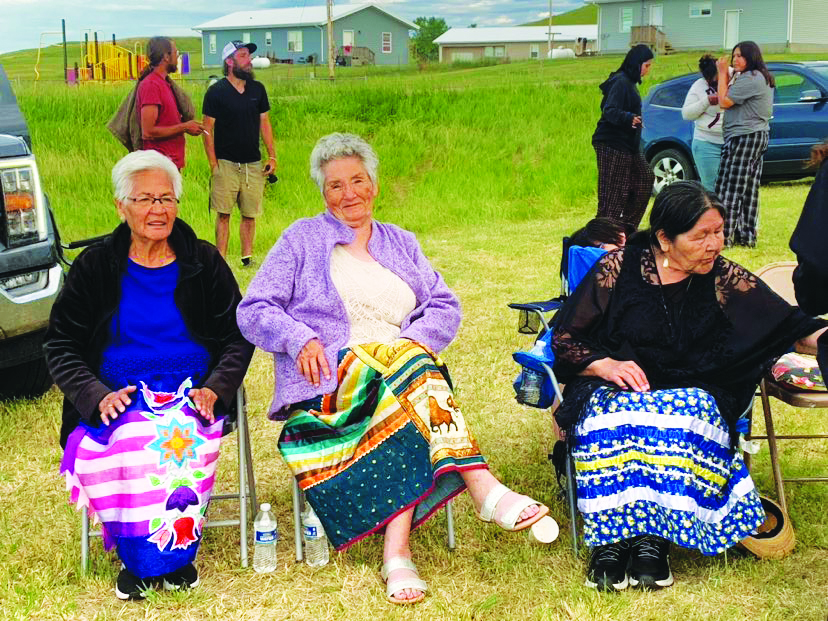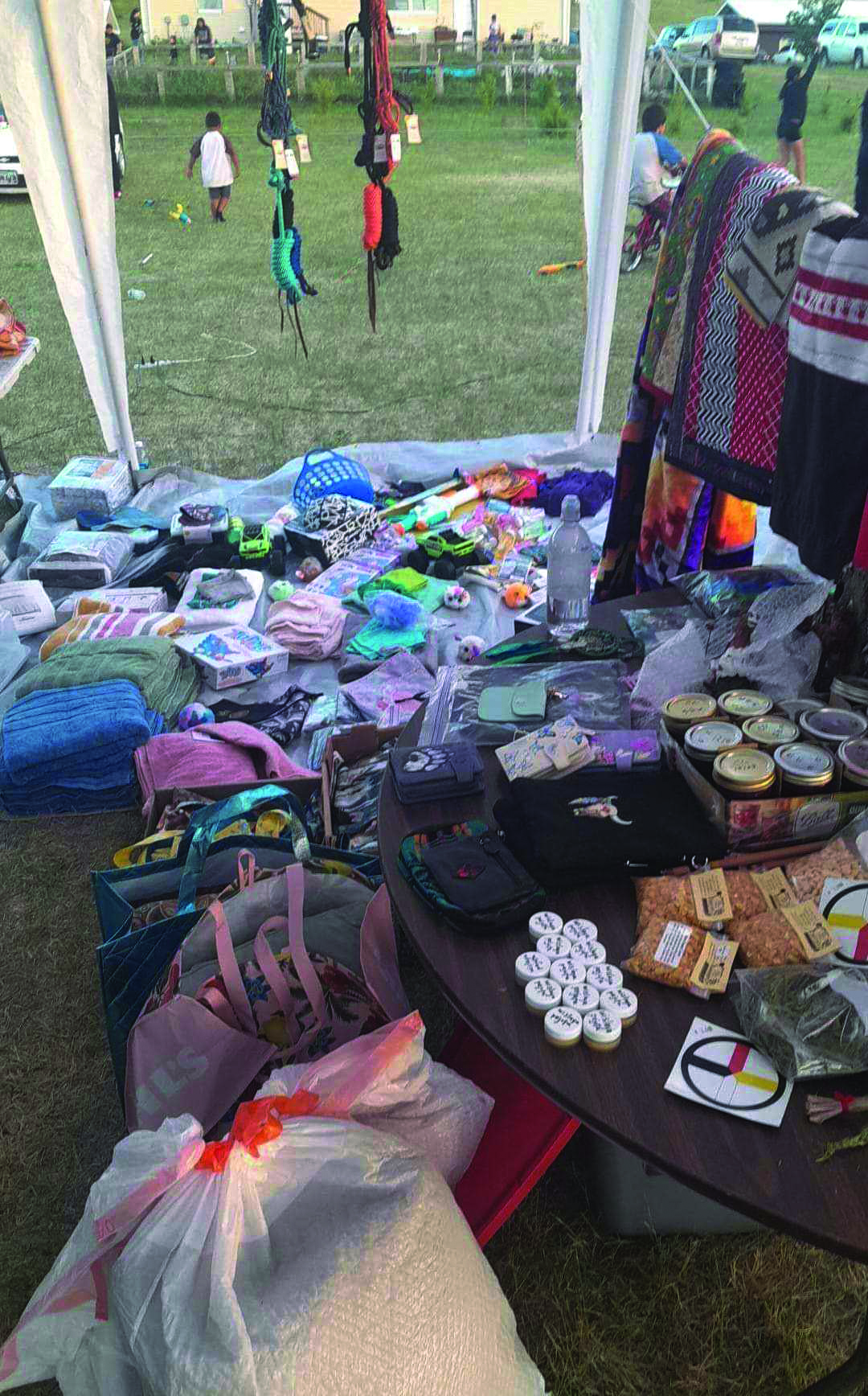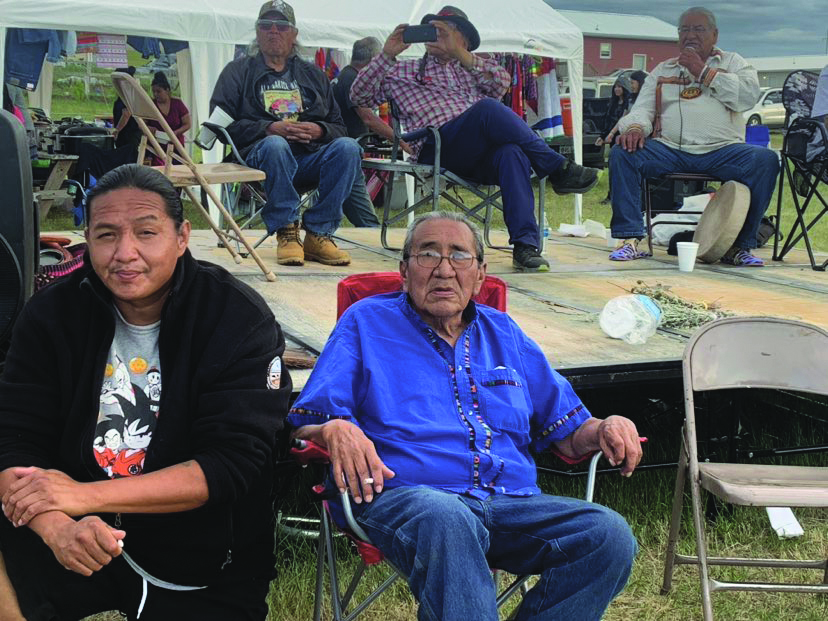Cheyenne River Lakota elder honor Pte San Win after memorial ride

DelMarie Bradford (Oglala), Barbara Dull Knife (Oglala), and Violet Catches (Minnecoujou) enjoy gathering to honor White Buffalo Calf Pipe Woman.
GREEN GRASS – On June 8, 2024, Ms. Vivian High Elk (Cheyenne River Lakota) of the Green Grass, SD community hosted an estimated 300 relatives with a traditional meal and giveaway at her home. Many who attended were completing a memorial ride that began on May 25, 2024, at Santee, Nebraska.
High Elk invited the guests after receiving a message in a dream several years ago from Pte San Win, the White Buffalo Calf Pipe Woman. High Elk’s ancestry includes relatives from the Minnicoujou, O’ohenumpa, and Itazipco bands of the Lakota.
The latter band is known traditionally as the keepers of the sacred pipe, a gift from the White Buffalo Calf Pipe Woman. High Elk said Pte San Win spoke to her in the Lakota language and instructed her to host the event to spread a message of love, peace and unity.
According to Kaili Berg (Aleut), a member of the Alutiiq/Sugpiaq Nation, “Among the Lakota people, the white bison holds a special place in their spirituality and traditions (and) …is central to their beliefs.
“According to (oral history), a white buffalo calf appeared to the Lakota many generations ago and transformed into a beautiful woman who taught them sacred ceremonies and imparted important spiritual knowledge. The White Buffalo Calf Woman promised to return again, signaling a time of peace and harmony.
“Other tribes also revere the white bison. For these tribes, the white bison symbolizes purity, spirituality, and the promise of prosperity. It is believed to be a powerful omen and a message from the Creator.”
Since receiving the message from Pte San Win in the dream, High Elk has been preparing and making plans for the event but did not set a date, time, or place until she heard of this memorial ride. When she heard of the ride, she knew that this was the time and the people she was meant to bless.
According to Andrea Eastman (Dakota of Lake Traverse Reservation) of Sisseton, SD, the memorial ride was completed in three segments, the first being from Santee to the Crow Creek Reservation in SD. She is a descendant of Dr. Charles Eastman (Santee Dakota), the first Native American to be certified in Western medicine, who gave medical treatment to wounded Lakota after the 1890 Wounded Knee massacre.
The people of the Crow Creek Tribe are mostly descendants of the Mdewakanton Dakota Tribe of south and central present-day Minnesota. They were expelled from Minnesota, along with the Santee Dakota Tribe and Ho-Chunk Nation, following the U.S. – Dakota War of 1862.
In the first six months at Crow Creek more than 200 Dakota people died, most of them children. Hundreds more died by massacre, execution, and starvation as a result of the war. This first leg of the memorial ride was in honor of all Dakota who died fighting for their people and their land, especially the women.
Jimmy Hallum (Dakota of the Santee Reservation) was one of the organizers of the ride. He noted that the crisis of Missing and Murdered Indigenous Relatives (MMIR) is not only a modern-day epidemic but has been a tragedy throughout Native American history since European colonizers arrived. He said that since 1862 many Crow Creek Reservation women were kidnapped, enslaved, abused, and never seen or heard from again.
The second segment of the ride was from the Crow Creek Reservation to the state capitol in Pierre, SD. The riders held a speaker event at the capitol to raise awareness of the MMIR issue.
Eastman and Hallum both say that there is an attitude of indifference in Pierre about MMIR. Hallum said that several years ago Governor Kristi Noem joined the ride briefly and promised more state resources would be devoted to MMIR but as yet there has been no follow-up from the governor or other state officials.
Eastman says, “It seems that we (Native Americans) are disposable. (When a Native American is missing,) the attitude seems to be ‘that’s just another Indian gone.’” Hallum said, “(In Pierre,) we (Native Americans) don’t matter.”
The third segment of the ride was from Pierre to Green Grass specifically to honor the White Buffalo Calf Pipe Woman. While the group has made this ride for several years, this is the first year the riders extended their journey as far as Green Grass.
In Green Grass, the riders visited the home of Orville Looking Horse, the current keeper of the sacred pipe. They spoke briefly to pay homage and made offerings to honor the White Buffalo Calf Pipe Woman.
Hallum noted that when the government sent Native children away to boarding schools, one of the goals was to forcibly assimilate the children by Christianizing them and erasing the influence of the White Buffalo Calf Pipe Woman. Her story is now often called a myth or a legend.
Hallum noted emphatically, “The White Buffalo Calf Woman is REAL – just as real as Jesus Christ being born in a manger in Bethlehem. She taught us our way of life. …” High Elk said, “The White Buffalo Calf Pipe Woman is still a living spirit and with us all the time.”
The riders then made their way to the home of High Elk who said, “The White Buffalo Calf Pipe Woman blessed us with good weather. It was 70 degrees and the winds were calm. The next day it rained with high winds.”

Gifts handmade by Lakota women offered to guests gathered at the home of Vivian High Elk in Green Grass on June 8 in honor of White Buffalo Calf Pipe Woman
High Elk welcomed the riders and other guests with a lavish giveaway of handmade gifts and a traditional Lakota meal. She had been gathering gifts for years. Mary Lopez, Betty Skaroupka, Violet Catches and many other friends and relatives contributed shawls, ribbon skirts, jewelry made with beads, quills, and bones, star blankets and other handmade items for the give-away.
Those attending then enjoyed a traditional Lakota meal which included buffalo meat, venison, dried corn, wastunkala, tanija (tripe soup), menudo (soup cooked with hominy), papa (dried meat), beef vegetable soup, homemade biscuits and frybread. Beverages included coffee and ceyaka (wild mint tea). Guests also enjoyed a cake specially decorated with an image of the White Buffalo Calf Woman.
Harold Frazier and Frank King provided the buffalo meat and nephew Dugan Bad Warrior provided beef. High Elk noted that some of the menu items required two days of preparation.
Ivan Looking Horse, a Cheyenne River Lakota elder, came to the event and served as eyapaha (emcee). Using spirit foods of wasna (pemmican made of dried meat, choke cherry and corn) and cheyaka (mint tea) prepared by his spouse Joanne Wilkinson, he blessed the food, the riders, the gifts, and the occasion.
Looking Horse explained elements of the ceremony as he progressed through the ritual. Eastman said that this was particularly meaningful to young riders who may have had limited opportunities to learn about Lakota traditions and culture. Hallum said, “The kids riding with us – that’s the biggest thing. …We need to teach our sacred ways of life (received from the White Buffalo Calf Pipe Woman) to the young people.”

Lakota Medicine Man Robert Rattling Chase (right in foreground) and his nephew enjoy June 8 gathering at the home of Vivian High Elk honoring the White Buffalo Calf Pipe Woman. In the background (l-r) is Delano Cook, Emanuel Red Bear (descendant of Elk Head), and Ivan Looking Horse (descendant of Martha Elk Head Bad Warrior), Eyapaha.
At one point during the event, Robert Rattling Chase, a medicine man from Rapid City, SD, took the microphone and said to High Elk, “You’re done. The White Buffalo Calf Pipe Woman spoke to me and told me that all (her instructions to you) have been fulfilled.”
High Elk said that she was greatly relieved upon hearing this. She had been worried about the weather and worried if there would be enough food and gifts for the giveaway. She said, “It is all about bringing family together to express love.”
Speaking of High Elk, Hallum said, “She has a good heart.”
Eastman said that riding away from the event, she felt strength, unity, power, love, compassion and happiness. She found it especially meaningful that she had traveled so far away from her own home and people and felt so welcomed. “It was like a home away from home.”
(Contact Grace Terry at grace@angelsabide.com)
The post Cheyenne River Lakota elder honor Pte San Win after memorial ride first appeared on Native Sun News Today.
